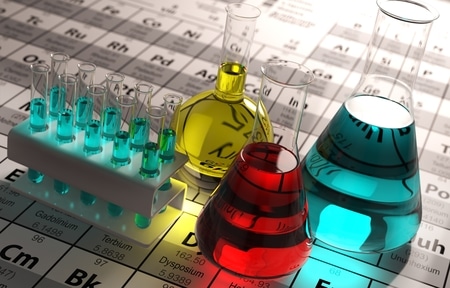Insights from Quantum SDS Services Team
Quantum Compliance has a full spectrum of SDS Services—from generating new SDS, to updating those that have gone out of date, to a quality control accuracy review of SDS, to general consulting about the authoring and management of SDS. We had the opportunity to talk to Chhanda Anarkali, Manager of Customer Service, for Quantum’s SDS Services to understand more about the benefits of working with Quantum SDS Services.
Chhanda, why do people need SDS’s?
Every time any company or supplier ships chemicals anywhere in the country or around the world, it is mandated that they provide a Safety Data Sheet. To be in compliance with the regulatory bodies nationally and internationally, they must provide this sixteen-section document when shipping a chemical or chemical mixture from a facility to another location… to a warehouse… to any destination.
With the Global Harmonized System (GHS), this is now an internationally recognized standard created by the United Nations, that most countries follow, including the US?
All countries follow it with slight variations. Europe and Canada for example want things in a little different format but they all follow the basic GHS classification of all the chemicals. So, for example a customer may say, “Oh, I need it in the Canadian format…” and that’s when we say, “You cannot have a Canadian format without French.” Sometimes, because of budget, they may not request it right away, but eventually they will come back to us for the French version.
What is the key to creating an accurate and compliant SDS?
The key is the formula itself. That is the first thing we would check. Of course, it has a name… and a manufacturer… the basic things, but the main thing that we really need to get started is the formula itself, which is Section 3 in the SDS standard form. The mixture is a set of chemicals with their CAS numbers. A CAS number is a universally recognized, unique and unmistakable numerical identifier of each chemical assigned by the Chemical Abstracts Service (CAS) to every chemical substance. It currently identifies more than 183 million unique organic and inorganic substances and 68 million protein and DNA sequences. (https://www.cas.org/about/cas-content)
And a customer would also give the percent weight to us, so we know how much of the chemical is in the mixture. That will determine its classification. If a customer cannot give us the CAS number and the percent weight, we put it on hold. Once they do, we can start work. Now sometimes a customer may have a concern about revealing their formula to us—it is their intellectual property, their proprietary information–so we assure them of our confidentiality and if needed we sign an NDA.
What do you mean by “percent weight”?
So, we need to know what percent of the total weight of the mixture a certain chemical is. 90%, 50%, 1%? And, based on that, we can define the classification. So, for example, if a customer reports it too high, then the mixture might be over-classified. So, they must tell us the exact percentage, so we don’t over-classify or under-classify—but classify it accurately. That’s really the goal—to know what to send off in an SDS with the mixture’s classification expressed accurately. And there’s no fudging on this. The numbers dictate the classification based on the GHS. And of course, that’s what we communicate back to our customers.
So, you’re not just reporting—you’re classifying it. And that will then dictate the precautionary measures that people would use.
Correct. So, your mixture formula can be made up of, let’s say, four chemicals, for example. And out of the four chemicals, we need to know the CAS and the percent weight. Each of these chemicals has its own classification under the GHS as a pure chemical. If for a moment, we pretend that each of these chemicals were 100%, GHS classifies them in a certain way. However, when you place this chemical into a mixture—and it may be just 1% of it… or 3%… or 10%, that defines the mixture’s classification differently. And of course, a mixture of four chemicals would also be classified differently. So, as a mixture, it might just be a skin irritant instead of… you know, if a given chemical in the mixture was 100%, it could be toxic for us.

Here’s an excerpt from an article on hand sanitizers that gives an example of how important it is to know what chemicals are in the products you’re using—especially when you’re coming into direct contact with them.
Because many of us are required to provide hand sanitizer at school, we have to figure out what brands we can trust, which products are truly safe and which ones to avoid. With few exceptions, hand sanitizers across the board consist of three active ingredients: alcohol, benzalkonium chloride and benzethonium chloride. Of the three, our choice is alcohol with its long-proven track record of minimal hazard with maximum effectiveness. Triclosan used to be common in disinfectant products like hand sanitizers and antibacterial soaps, but it was banned from hand and body products in 2016 due to its toxic nature.
https://pardonmyplants.com/safe-hand-sanitizer-brands-to-avoid/
https://www.npr.org/sections/health-shots/2016/09/02/492394717/fda-bans-19-chemicals-used-in-antibacterial-soaps
An SDS identifies all of the chemicals in a product and makes certain that employees or the public who come in contact with these chemicals will know how to handle them safely and what to do if there is improper exposure.
So Quantum Software figures out the mixture classification based on what the GHS has told you, so that if a chemical represents X net weight or inside a range of net weight, it will tell you what classification that is.
Yes. So, there is that 700 pages of the UN documentation that is programmed into our software. So, we have already pre-done that, so you don’t have to be an expert on the document because it’s already in the system… and we update it on a regular basis. But, you know, if it’s less than this or if it’s between this, if the flashpoint is this, and if there’s all these rules for different chemicals… if it’s a liquid, if it’s a gas… different kinds of things happen. And all that is in, what we call, the “ingredient rules” in the software.
So let’s say you have a mixture, and you know the CAS and the net weight, do you submit this to the software, it looks at it and then presents back the classifications?
Yes. Pretty powerful, isn’t it.
How can customers be certain of the accuracy of the SDSs you author, update, or review for them?
Well, we follow a strict quality assurance process in developing the SDS and we are constantly updating our software with any changes in the regulations. Plus, many new customers find it comforting to know that we’ve been doing SDSs for over 30 years. The Quantum team of chemical engineers and subject matter experts have deep experience in the field.
What else does Quantum offer?
Trade secret protection built into the reporting, 24-hour guaranteed response to initial inquiry, translation into 38 languages, 7-day turn-around…And I’m glad to let you know that right now until July 15, 2021, we have a special offer for both new and current customers. Take a look below.







